Themed collection Antimicrobial Resistance

Introduction to the themed collection on antimicrobial resistance
Guest editors Jayanta Haldar, Sylvie Garneau-Tsodikova and Micha Fridman introduce the RSC Medicinal Chemistry themed collection on ‘Antibiotic microbial resistance’.

RSC Med. Chem., 2023,14, 1398-1399
https://doi.org/10.1039/D3MD90016A
Structural insights into the activity of carbapenemases: understanding the mechanism of action of current inhibitors and informing the design of new carbapenem adjuvants
Active sites of the a serine- (OXA-23 [PDB 4JF6]) and b metallo- (NDM-1 [PDB 5YPL]) β-lactamases.

RSC Med. Chem., 2025, Advance Article
https://doi.org/10.1039/D5MD00732A
Navigating the complexities of drug development for metallo-β-lactamase inhibitors
Standardized approaches to MBL inhibitor development are vital. This work highlights the benefits of uniform methodologies while addressing key preclinical challenges to bridge the gap toward successful clinical translation.

RSC Med. Chem., 2025,16, 3393-3415
https://doi.org/10.1039/D5MD00035A
Chemical genetic approaches for the discovery of bacterial cell wall inhibitors
High-throughput chemical genetic screening strategies for bacterial cell envelope inhibitors.

RSC Med. Chem., 2023,14, 2125-2154
https://doi.org/10.1039/D3MD00143A
Restoring susceptibility to aminoglycosides: identifying small molecule inhibitors of enzymatic inactivation
Growing resistance to antimicrobial medicines is a critical health problem that must be urgently addressed.
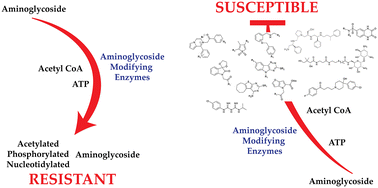
RSC Med. Chem., 2023,14, 1591-1602
https://doi.org/10.1039/D3MD00226H
Recent developments in membrane targeting antifungal agents to mitigate antifungal resistance
Fungal infections cause severe and life-threatening complications especially in immunocompromised individuals.
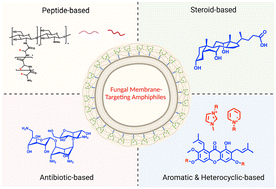
RSC Med. Chem., 2023,14, 1603-1628
https://doi.org/10.1039/D3MD00151B
Dual functional therapeutics: mitigating bacterial infection and associated inflammation
Dual-functional therapeutics with the ability to tackle both bacterial infection and associated hyper-inflammation hold great promise for mitigating complicated infections and sepsis.

RSC Med. Chem., 2023,14, 1410-1428
https://doi.org/10.1039/D3MD00166K
Siderophore conjugates to combat antibiotic-resistant bacteria
Antimicrobial resistance (AMR) is a global threat to society due to the increasing emergence of multi-drug resistant bacteria that are not susceptible to our last line of defence antibiotics: new approaches are needed to fight back.
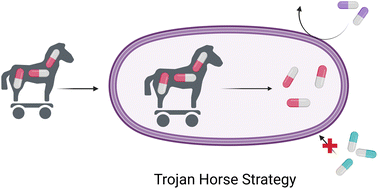
RSC Med. Chem., 2023,14, 800-822
https://doi.org/10.1039/D2MD00465H
Ribosome-targeting antibiotics and resistance via ribosomal RNA methylation
The rise of multidrug-resistant bacterial infections is a cause of global concern.
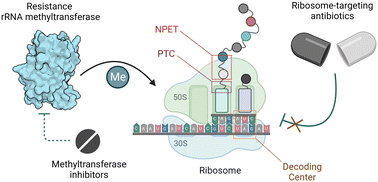
RSC Med. Chem., 2023,14, 624-643
https://doi.org/10.1039/D2MD00459C
The role of adjuvants in overcoming antibacterial resistance due to enzymatic drug modification
Enzymatic drug deactivation is an important contributor to bacterial resistance. Adjuvants which inhibit the β-lactamases help maintain the efficacy of the β-lactams, demonstrating the potential for this strategy for other antibacterial classes.
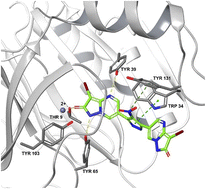
RSC Med. Chem., 2022,13, 1276-1299
https://doi.org/10.1039/D2MD00263A
Inhibition of DXR in the MEP pathway with lipophilic N-alkoxyaryl FR900098 analogs
Isoprene biosynthesis is a point of vulnerability for many pathogens. Building on prior work, we report a novel set of potent compounds that display selectivity for P. falciparum over M. tuberculosis, and act on-target intracellularly.

RSC Med. Chem., 2024,15, 2422-2439
https://doi.org/10.1039/D3MD00642E
Discovery of benzoxazole–thiazolidinone hybrids as promising antibacterial agents against Staphylococcus aureus and Enterococcus species
Increase in activity of B–T hybrids with halo-salicyl group on thiazolidinone against S. aureus ATCC 29213.

RSC Med. Chem., 2023,14, 1712-1721
https://doi.org/10.1039/D3MD00290J
Enhancing allosteric inhibition of dihydrodipicolinate synthase through the design and synthesis of novel dimeric compounds
The synthesis of the first low micromolar dimeric inhibitor of E. coli DHDPS is reported.

RSC Med. Chem., 2023,14, 1698-1703
https://doi.org/10.1039/D3MD00044C
Design, synthesis and evaluation of halogenated phenazine antibacterial prodrugs targeting nitroreductase enzymes for activation
In this study, we have designed, synthesized, and evaluated new halogenated phenazine prodrugs that could lead to breakthroughs in the treatment of antibiotic-resistant bacterial infections.

RSC Med. Chem., 2023,14, 1472-1481
https://doi.org/10.1039/D3MD00204G
Discovery and development of novel substituted monohydrazides as potent antifungal agents
Novel substituted monohydrazides synthesized for this study displayed broad-spectrum activity against various fungal strains, including a panel of clinically relevant Candida auris strains.

RSC Med. Chem., 2023,14, 1351-1361
https://doi.org/10.1039/D3MD00167A
Detection of intact vancomycin–arginine as the active antibacterial conjugate in E. coli by whole-cell solid-state NMR
Vancomycin–arginine (V–R) is effective against antibiotic-resistant Gram-negative pathogens. We designed a whole-cell solid-state NMR approach and detected intact V–R in E. coli, indicating no hydrolysis or liberation of the conjugated arginine.

RSC Med. Chem., 2023,14, 1192-1198
https://doi.org/10.1039/D3MD00173C
Synthesis of tryptanthrin appended dispiropyrrolidine oxindoles and their antibacterial evaluation
The synthesis of sixteen tryptanthrin appended dispiropyrrolidine oxindoles, employing [3 + 2] cycloaddition of tryptanthrin-derived azomethine ylides with isatilidenes, and their detailed antibacterial evaluation is described.

RSC Med. Chem., 2023,14, 1165-1171
https://doi.org/10.1039/D3MD00017F
Identification and analysis of small molecule inhibitors of FosB from Staphylococcus aureus
High-throughput virtual screening has identified several new inhibitors of FosB from methicillin-resistant Staphylococcus aureus.

RSC Med. Chem., 2023,14, 947-956
https://doi.org/10.1039/D3MD00113J
Mycobacterium tuberculosis CitA activity is modulated by cysteine oxidation and pyruvate binding
The M. tuberculosis citrate synthase regulatory domain binds pyruvate to affect enzyme activity while cysteine oxidation in the same domain eliminates enzyme activity. This affords regulatory control at the protein level of entry to the TCA cycle.

RSC Med. Chem., 2023,14, 921-933
https://doi.org/10.1039/D3MD00058C
Semisynthetic blasticidin S ester derivatives show enhanced antibiotic activity
A potential rich source of new antimicrobials is undeveloped natural product cytotoxins. We used semisynthesis to derivatize the neglected antibiotic blasticidin S, creating ester derivatives with enhanced selectivity for bacteria.
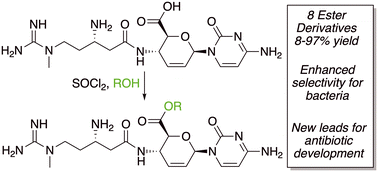
RSC Med. Chem., 2023,14, 782-789
https://doi.org/10.1039/D2MD00412G
Inhibition and eradication of Pseudomonas aeruginosa biofilms by secondary metabolites of Nocardiopsis lucentensis EMB25
Promising activity of secondary metabolites extracted from a rare actinobacteria, Nocardiopsis lucentensis EMB25 against biofilm of Pseudomonas aeruginosa.

RSC Med. Chem., 2023,14, 745-756
https://doi.org/10.1039/D2MD00439A
Dimeric polyphenols to pave the way for new antimalarial drugs
A polyphenolic scaffold to develop novel orally active antimalarials against resistant Plasmodium falciparum.

RSC Med. Chem., 2023,14, 715-733
https://doi.org/10.1039/D2MD00392A
The Mycobacterium tuberculosis mycothiol S-transferase is divalent metal-dependent for mycothiol binding and transfer
Mycothiol S-transferase (MST) (encoded by the rv0443 gene) was previously identified as the enzyme responsible for the transfer of mycothiol (MSH) to xenobiotic acceptors in Mycobacterium tuberculosis (M.tb) during xenobiotic stress.

RSC Med. Chem., 2023,14, 491-500
https://doi.org/10.1039/D2MD00401A
Expanding the structure–activity relationships of alkynyl diphenylurea scaffold as promising antibacterial agents
With the continuous and alarming threat of exhausting the current antimicrobial arsenals, efforts are urgently needed to develop new effective ones.
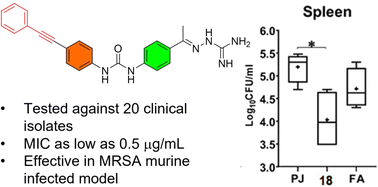
RSC Med. Chem., 2023,14, 367-377
https://doi.org/10.1039/D2MD00351A
Synthesis and structure–activity relationship studies of N-terminal analogues of the lipopeptide antibiotics brevicidine and laterocidine
SAR studies on brevicidine and laterocidine yield new analogues with strong activity against multidrug-resistant Gram-negative bacteria.

RSC Med. Chem., 2022,13, 1640-1643
https://doi.org/10.1039/D2MD00281G
About this collection
This themed collection, guest edited by Professor Micha Fridman (Tel Aviv University, Israel), Professor Sylvie Garneau-Tsodikova (University of Kentucky, USA) and Professor Jayanta Haldar (Jawaharlal Nehru Centre for Advanced Scientific Research, India), highlights the latest medicinal chemistry advances in tackling drug resistance. This collection covers various areas related to antimicrobial (fungi, bacteria, and viruses) drug discovery and development, as well as research towards understanding the mechanisms of resistance.
New articles will be added to the collection upon publication. Please return to this page frequently to see the collection grow.